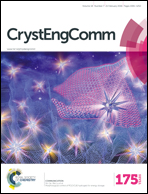Two new three-dimensional metal–organic frameworks with 4-connected diamondoid and unusual (6,16)-connected net topologies based on planar tetranuclear squares as secondary building units†
Abstract
Solvothermal reactions of Co2+ and Mn2+ salts with 2-(trifluoromethyl)-1H-4,5-imidazole dicarboxylic acid (H3TFMIDC) lead to two novel three-dimensional (3D) metal–organic frameworks (MOFs), namely, [Co6(μ3-TFMIDC)4(H2O)12]·15H2O (1) and [(Me2NH2)3][MnII6 MnIII(μ3-TFMIDC)6(H2O)6]·18H2O (2). Single-crystal X-ray diffraction analysis reveals that both of them are based on interesting planar tetranuclear squares [M4(TFMIDC)4] as secondary building units (SBUs). Compound 1 exhibits a unique 3D two-fold interpenetrated network with the diamondoid topology consisting of the tetranuclear square SBUs as 4-connected nodes, while compound 2 features an unusual (6,16)-connected 3D framework based on the novel tetranuclear square SBUs as 16-connected nodes and trivalent manganese ions as 6-connected nodes, representing the first 16-connected MOF utilizing planar tetranuclear square SBUs as building blocks. Our results open up new perspectives to design novel 3D extended MOFs, especially the unique highly connected 3D MOFs by employing planar tetranuclear square SBUs. Moreover, IR spectroscopy, powder X-ray diffraction, thermogravimetric analyses, and a study on the magnetic properties of both compounds, have been also performed.


 Please wait while we load your content...
Please wait while we load your content...